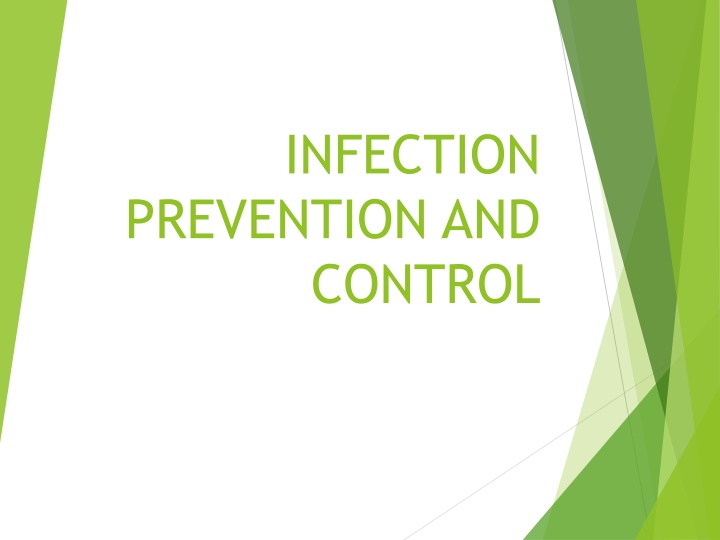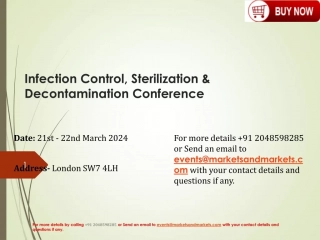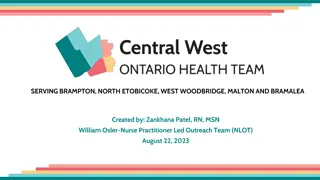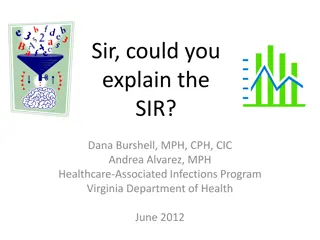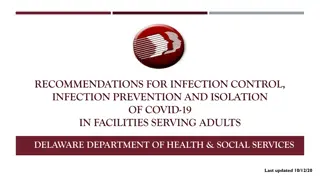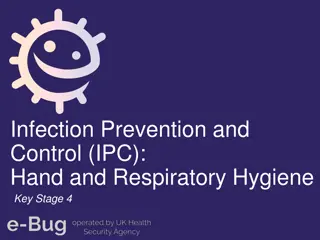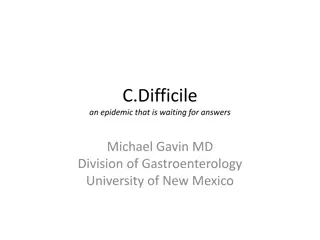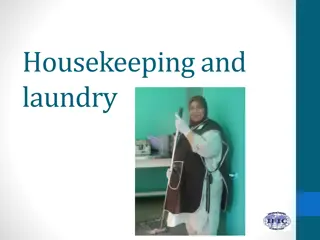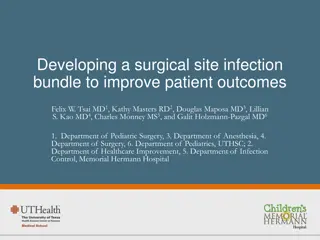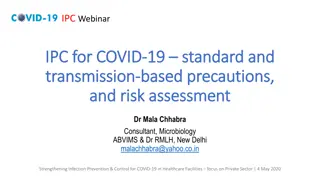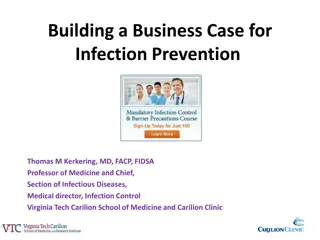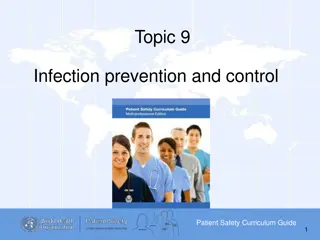Comprehensive Guide to Infection Prevention and Control
Understanding the essentials of infection prevention and control is crucial in healthcare settings. This guide covers key topics such as basic principles, standard precautions, specific infections, surveillance, and prevention methods. It explores the chain of infection, factors making individuals susceptible to infections, and the importance of hand hygiene. A detailed infection prevention manual is provided, emphasizing practices to minimize risks and manage outbreaks effectively. Standard precautions, including hand hygiene, personal protective equipment, waste disposal, and device management, are highlighted for routine safe practice. Overall, this guide serves as a valuable resource for healthcare professionals aiming to protect patients and staff from infections.
Download Presentation

Please find below an Image/Link to download the presentation.
The content on the website is provided AS IS for your information and personal use only. It may not be sold, licensed, or shared on other websites without obtaining consent from the author.If you encounter any issues during the download, it is possible that the publisher has removed the file from their server.
You are allowed to download the files provided on this website for personal or commercial use, subject to the condition that they are used lawfully. All files are the property of their respective owners.
The content on the website is provided AS IS for your information and personal use only. It may not be sold, licensed, or shared on other websites without obtaining consent from the author.
E N D
Presentation Transcript
INFECTION PREVENTION AND CONTROL
INTRODUCTION Basic principles Standard precautions Specific infections Infection surveillance Infection prevention group Audit
CHAIN OF INFECTION Source - micro-organism, e.g. bacteria, virus, fungi Reservoir where source lives e.g. humans, environment, soil Means of escape - e.g. coughing, vomiting, air currents, contaminated equipment Mode of transmission direct (person to person), indirect (person to object to person) Means of entry - way in which organism enters a host, e.g. ingestion, inhalation, injection, break in skin
WHAT MAKES SOMEONE SUSCEPTIBLE TO INFECTION? Lowered immunity Age very young or old Poor physical / psychological well-being Underlying disease e.g. diabetes Poor nutrition Stress Medical intervention: drug therapies, e.g. chemotherapy, steroids & antibiotics and presence of invasive devices, e.g. urinary catheters, intravenous infusions etc. Anyone can be susceptible if exposed to blood borne viruses
INFECTION PREVENTION MANUAL Provides: Guidance to minimise risk of infection Information on specific infections Action to take in event of an outbreak Results of infection surveillance Minutes from IPC team meetings Can be found on both wards (hard copy) or on computer system O/H drive
STANDARD PRECAUTIONS underpin routine safe practice protecting patients and staff washhand
STANDARD PRECAUTIONS INCLUDE: Achieving optimum hand hygiene Appropriate use of clinical personal protective equipment Safe handling and disposal of sharps Safe handling and disposal of clinical waste Managing blood and bodily fluids Decontaminating equipment Achieving and maintaining a clean environment Appropriate use of indwelling devices Managing accidents Good communication Training/education
HAND HYGIENE Infections (including MRSA) most commonly spread via hands of healthcare workers in hospital and other health care settings SINGLE MOST IMPORTANT ACTIVITY IN REDUCTION OF SPREAD OF INFECTION AND PREVENT PATIENTS ACQUIRING INFECTION IN HOSPITAL Hands must be cleaned before and after patient contact and after any task with a risk of hand contamination Hands may be decontaminated by hand-washing or use of alcohol hand rub In addition clinical staff should: Keep nails short, clean and polish free Avoid wearing jewellery or wristwatches especially rings with ridges or stones Not wear artificial nails
EQUIPMENT Conveniently situated hand basins Wrist, elbow or automatic taps Plentiful supply of paper towels in dispensers that allow easy access Liquid soap and hand lotion in disposable cartridges Alcohol hand rub in each patients room
HAND HYGIENE METHODS The two favoured hand hygiene methods are soap and water and alcohol based hand rubs are visibly soiled Better at removal of debris Faster and easily accessible Advantages of soap and water preferred option when hands Advantages of alcohol hand rub Less time needed Less hand irritation compared to repeated use of soap and water Removal of clostridium difficile spores - alcohol based hand rubs are less effective at removing spores than soap and water Less risk of re-contamination Increased usage several studies have reported increased rates of hand hygiene compliance after introduction of alcohol based systems
HAND WASHING PROCEDURE Roll up sleeves Run water till hand hot, direct flow away from plughole and run at a rate that does not splash Wet wrists and hands with running water Apply liquid soap to all surfaces of hands and wrists Lather surface for 10-15 secs Pay attention to nails, finger pads, thumbs and between fingers Do not use a nail brush Rinse hands under running water Hold hands downwards to drain water from fingertips Turn off taps using elbow or paper towels Dry hand thoroughly with paper towel Dispose in foot operated bin
PROCEDURE FOR USE OF ALCOHOL RUB Do not wet hands Dispense requires amount into palm of hand Spread thoroughly over both hands and wrists Pay attention to nails, finger pads, thumbs and between fingers Rub vigorously till dry
AREAS COMMONLY MISSED FOLLOWING HAND CLEANING
HAND DECONTAMINATION: Before: Performing invasive procedures Contact with a patient Preparing, handling or eating food Dispensing medicines Starting a shift
HAND DECONTAMINATION After: Contamination Removal of gloves Contact with a patient Using the toilet or toileting others Bed-making and handling laundry Handling contaminated waste Finishing a shift
LOOK AFTER YOUR HANDS!!! Damaged skin does not provide a barrier to infection and may become colonised Keep your skin in good condition by using hand lotion regularly
PERSONAL PROTECTIVE EQUIPMENT Used to protect patients and staff from risks of cross infection http://images.google.co.uk/images?q=tbn:nUu-wzHB0szDhM:http://www.boydcooper.com/cat_theatre/images/pg27.jpg Includes: Gloves Aprons Goggles
DISPOSABLE GLOVES Used when carrying out tasks with a risk of exposure to blood or bodily fluids or aseptic procedures Effectiveness depends on correct and appropriate use Single use item -put on immediately before contact , remove immediately afterwards Must be changed between patients and between different care or treatment activities for same patient Inappropriate use of gloves can result in cross contamination from one part of a patient s body to another and in some cases lead to serious infection Gloves are hazardous waste - dispose in tiger bins. Always wash your hands on removal of gloves
http://images.google.co.uk/images?q=tbn:X3_NjJ1aR49LJM:http://amercare.com/images/aprons_d.jpghttp://images.google.co.uk/images?q=tbn:X3_NjJ1aR49LJM:http://amercare.com/images/aprons_d.jpg PLASTIC APRONS Worn to prevent contamination of clothing: Direct patient care Bed-making Decontaminating equipment Waste disposal Discard as soon as task complete and wash hands Store safely to prevent dust accumulating
GOGGLES Should be worn during procedures where there is a risk of splashing Masks may be necessary if there is a risk of airborne infection e.g. multi drug resistant Tuberculosis (TB), SARS http://images.google.co.uk/images?q=tbn:v8HUiAYV7ZeDyM:http://www.tigerlair.com/hotdogandahalf/bear-goggles.jpg
SAFE HANDLING AND DISPOSAL OF SHARPS Main hazards are hepatitis and HIV 2ndonly to back injury as a cause of occupational injuries in health care workers Safe use and disposal vital in reducing risk
WE ARE ALL RESPONSIBLE TO ENSURE THAT THE SHARPS BIN CAN BE SAFELY USED, PERMANENTLY SECURED AND TRANSPORTED FOR DISPOSAL WITHOUT FEAR OF SPILLAGE
SHARPS AWARENESS Close temporary closure when not in use Lock when 2/3rds full Assemble it correctly. Snap lid on all round YOURRESPONSIBILITIES
WHAT IS THE CONSEQUENCE OF THIS ACTION?
IF YOU DONT GET THE POINT SOMEONE ELSE WILL! SO ...
DISPOSE OF SHARPS INTO DESIGNATED SHARPS BIN
NO DO NOT RE-SHEATH NEEDLES
NON CO-OPERATIVE PATIENT? GET HELP
SHARPS INJURY BLEED IT WASH IT REPORT IT
Sharps Injury Consult with the Senior Nurse on duty for further advice The patient involved in the sharps injury to be screened for infection status Report to HR, you might need to be referred to the Occupational Health Nurse
MANAGEMENT OF BODY FLUID SPILLAGE Use personal protective clothing Keep visitors and patients away from spill area Body fluids e.g. urine & faeces, NOT visibly blood stained, clean using hot water and detergent For blood spillages to hard surfaces use sodium hypochlorite solution. Contact time at least 2mins. Clean spill area with hot water and detergent Contact housekeeping for deep cleaning
DECONTAMINATING EQUIPMENT Outbreaks associated with dirty equipment Decontamination ensures re-usable items are safe Combination of cleaning; disinfection and sterilisation
RISK ASSESSMENT Equipment Level of cleaning Examples Equipment that: Enters a sterile body cavity Penetrates skin Touches a break in the skin Equipment that touches intact skin or mucous membranes Equipment must be fully cleaned and sterilised after each patient use. Surgical instruments HIGH RISK Equipment does not need to be sterile at the point of use but needs to be cleaned and sterilised between each patient Bedpans Urinals MEDIUM RISK Equipment that does not touch broken skin or mucous membranes or is not in contact with patients Equipment must be cleaned and/or disinfected after use Ophthalmoscope Bed cradle LOW RISK
Waste Management Correct use of bins White house waste Yellow Offensive non hazardous waste Orange Hazardous clinical waste Correct use of buckets transport from patient s room to soiled holding White Incontinence waste Grey/blue unsoiled bed linens/ clothes Any soiled items go to RED BAG Correct use of laundry bags Green unsoiled items Red soiled items
SINGLE USE EQUIPMENT Single use used on a single occasion then discarded Single patient use used on multiple occasions on same patient then discarded e.g. suction tubing
SINGLE USE EQUIPMENT Prior to use: Check properly sealed Check within expiry date Check correct item
ACHIEVING AND MAINTAINING A CLEAN ENVIRONMENT Bacteria can survive for long periods in the environment Can live quite happily in dust High standards of cleanliness helps reduce infection risks and increases public confidence Detergent and water is suitable for most purposes Cleaning clothes used for specific purposes and areas Buckets and mops stored clean and dry Operational standards document
APPROPRIATE USE OF INDWELLING DEVICES Urinary catheters Enteral feeding tubes Tracheostomy tubes Correct techniques vital to prevent acquired infections General guidance in Clinical and IPC manuals Information related to specific patients in relevant section of care plan
URINARY CATHETERS Increased risk of UTI in catheterised patients (UTI commonest cause of bacteraemia in patients in long term care) Assess need Look at alternatives Review regularly Remove ASAP Care plan
URINARY CATHETERS -Drainage options Intermittent catheterisation Smallest gauge catheter Sterile closed drainage system do not break connection unless changing bag Bags positioned below bladder level not too low on leg and definitely not on floor Empty bags frequently
ENTERAL FEEDING Minimal handling Pre- packaged feeds used Administration system compatible with tube changed weekly Feeds stored according to manufacturer s recommendations Keep stoma site clean Dressings not necessary Tubes changed according to manufacturer s recommendations Tubes flushed with fresh tap water unless otherwise indicated
TRACHEOSTOMY Keep area clean and dry Clean with normal saline Frequency of dressing changes depends on secretions Suctioning as required by individual patients Tracheostomy tubes changed 4 weekly Inner tubes at least every 4 hours Inner tubes cleaned with warm water and cleaning swab, dried and stored in plastic sealed container Swedish noses changed as required Piped and portable suction unit
Specific Infections MRSA Gastroenteritis Clostridium Difficile Influenza
MRSA Staphlococcus resistant to Methicillin and some other antibiotics but remains treatable Staphlococcus aureus found on 30-40% of population, has been around for decades MRSA carried by 2% of population with no symptoms or ill effects Only becomes a problem when normal body defences compromised e.g. by surgery or trauma Infections (including MRSA) can be treated with a number of antibiotics
http://images.google.co.uk/images?q=tbn:1rSMsTlV61uLCM:http://www.thesahara.fsnet.co.uk/MRSA/mrsa_infection_bad.jpghttp://images.google.co.uk/images?q=tbn:1rSMsTlV61uLCM:http://www.thesahara.fsnet.co.uk/MRSA/mrsa_infection_bad.jpg MRSA Colonisation: No symptoms Swabs or samples will grow the bacteria Can be colonised in: moist areas rough or damaged skin chronic wounds Infection: Pain & fever Redness & swelling Unpleasant discharge Wound breakdown Can be life threatening if bacteria gets into deep tissues or blood stream
WHAT TO DO Routine screening not necessary Treat colonisation only if patient undergoing invasive procedure i.e. surgery No need to re- screen unless clinical indication e.g. admission for surgery Prevention better than cure - standard precautions/good hand decontamination No need to isolate unless bacteria can not be contained Can have visitors and go out Laundry does not need to be segregated wash on hottest temperature, personal items 40 C
GASTROENTERITIS Infection of GI tract Affects approx 1 in 5 of population each year Symptoms caused by toxins produced by virus or bacteria irritating the GI tract causing excess fluid production Usually symptoms subside without specific treatment
